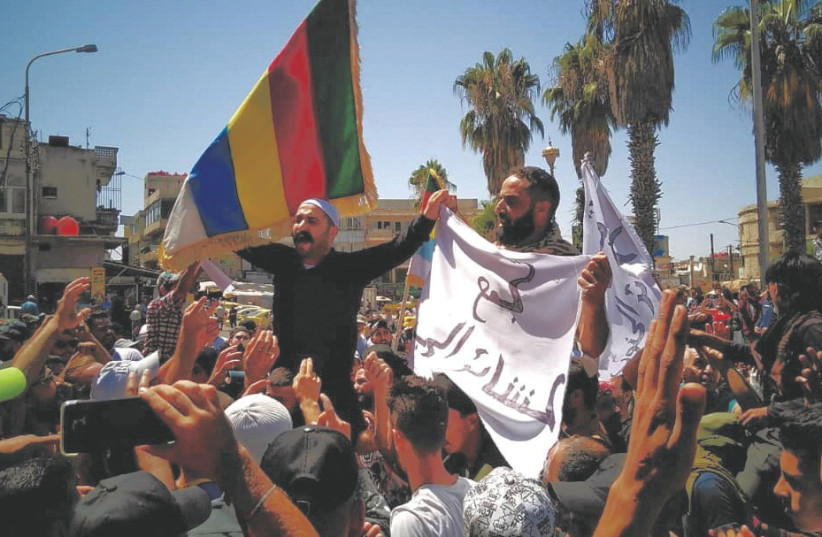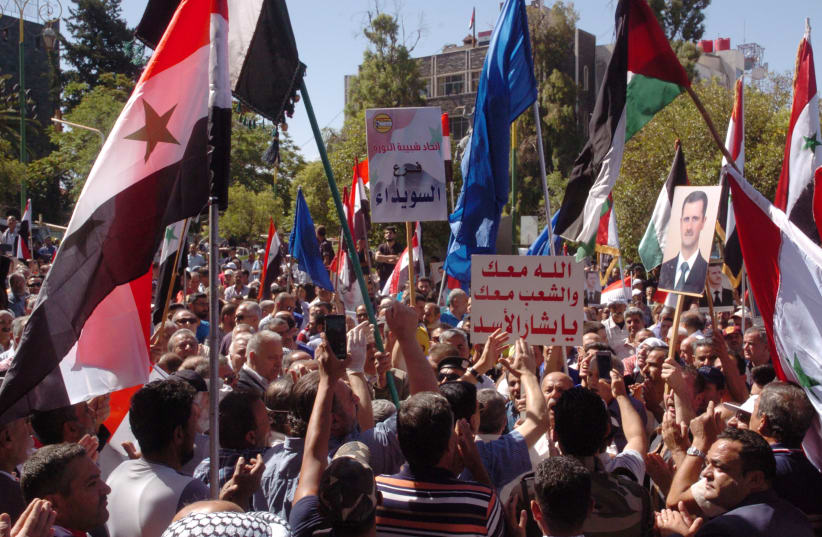Two weeks of protests in southern Syria by the Druze minority in the city and district of Suwayda have led to discussions by members of the community in Israel and Lebanon about solidarity for those in Syria.
The protests in Syria are momentous and come after many years where the minority community has suffered in southern Syria. While the Druze did not mostly join or support the Syrian rebellion, they also faced complex challenges from the Syrian regime. The regime has often threatened to unleash extremists against them. ISIS attacks are one example.
While the Syrian regime has now returned to normalization with much of the region, the regime still faces internal crisis. It doesn’t control eastern or northern Syria. Druze in Suwayda complain of many issues, including economic problems. Protests have been ongoing for two weeks and they are considered some of the largest protests against the regime in Suwayda since 2011.
The protests have included chants against the Assad regime. Now that protesters appear to be directing more anger at the regime, rather than just protests regarding various issues, such as fuel costs, there are concerns that the regime may resort to violence or enable attacks by extremists.
The protests continue in Suwayda and may spread to other areas. The Syrian regime has weak control over some areas such as Dara’a and areas near Suwayda.

Druze in Syria have been at the center of this complexity in the past.
During the early years of the Syrian Civil War, the regime relied on Druze for support and there were Druze officers in the regime’s army that played a key role. Attacks by extremists against Druze also led communities to feel that the Syrian rebellion might turn on them. In the town of Khader near the Golan for instance the regime was able to control the Druze town while rebels controlled nearby areas. This led to controversy in Druze areas in the Golan.
For instance, protesters in places like Majdal Shams expressed anger at Syrian rebels who they claimed were receiving aid from Israel. In 2015 an ambulance transporting wounded from Syria was attacked by protesters. Ynet noted at the time “For the second time in 24 hours, Druze in northern Israel pelt ambulance with stones; two IDF soldiers lightly hurt in attack, one of the Syrian wounded killed.”
Reports now indicate that Druze communities in Lebanon and Israel are paying close attention to developments in Syria. A report says that Talal Arslan, a Druze leader in Syria has put out a statement about Druze in Lebanon not getting involved in the issues in Syria. In the past, Arslan has been seen to be supportive of the Syrian regime. He suffered political setbacks in 2022.
Druze in Golan Heights protest in support
On Friday, there were demonstrations in Majdal Shams in the Golan in support of the protests.
Videos showed dozens with flags, some of the flags were those of the Syrian rebellion which have three stars rather than the two-starred regime flag. Other demonstrators held the colorful Druze flag. Druze in the Golan are residents of villages annexed by Israel after the 1967 war. Their status and ties to Israel have often been different than Druze in the rest of Israel who serve in the IDF.
This complexity meant that for many years, the Syrian regime encouraged Druze in the Golan to portray themselves as supportive of the regime. Much changed after 2011, and differing community views of the regime exist. Recent protests against wind turbines in the Golan have also led to tensions with Israeli authorities. Media in the region often refer to the Golan as “occupied.” The protests Friday showcased that many are closely following the Suwayda protests and oppose the regime.
The Syrian regime portrays protests in Suwayda as a plot and worries that it has broader implications. It also believes this is sedition. There are also differing voices in Suwayda. A report at the pro-Iran Al-Mayadeen noted on Saturday that a Druze spiritual leader had distanced the religious leadership from a statement by former Druze officers. HIkmat Al-Hijri, the spiritual leader, and one of several leading religious leaders in the community, is seen as more supportive of the protests, while the regime seeks to pressure other religious leaders to remain supportive of Damascus.
The protests in Suwayda come as there are also clashes between Syrian tribes in the Euphrates river valley targeting the US-backed SDF. The tribes are Sunni but some may be receiving quiet help from the regime because the regime opposes the US. Iran sent its foreign minister to Syria last week to tell the US to “go home” from Syria. Turkey and Iran also oppose the US in Syria and both are seeking to exploit the tribal conflict with the SDF. Turkey carried out airstrikes according to reports on Saturday.
Syrian regime official injured in car bombing
Instability continues in other areas of southern Syria. A member of the Syrian regime who was the head of the Sasa district southwest of Damascus was injured in a car bombing when his truck exploded over the weekend, pro-Syrian media reported. The man, named Mohammed al-Ahmed, was apparently the target and the bomb was planted in his car, local reports said. He was taken to a hospital initially in Qatana, social media reports said.
Photos online show the official before the explosion in a regime uniform and also in hospital. They also show a white pickup truck that was damaged. His rank is variously given as Lt. Col and Major. Al-Mayadeen, which is considered pro-Iran and pro-Syrian regime, reported the bombing and linked it to other attacks in the region. It noted that ISIS had carried out other attacks. However, there have also been many attacks on Syrian regime members in southern Syria. Southern Syria was reconquered by the regime in 2018, including areas near the Golan. However, this area also has many former rebels who chose to reconcile with the regime rather than fight, but they have been disappointed in years since.
